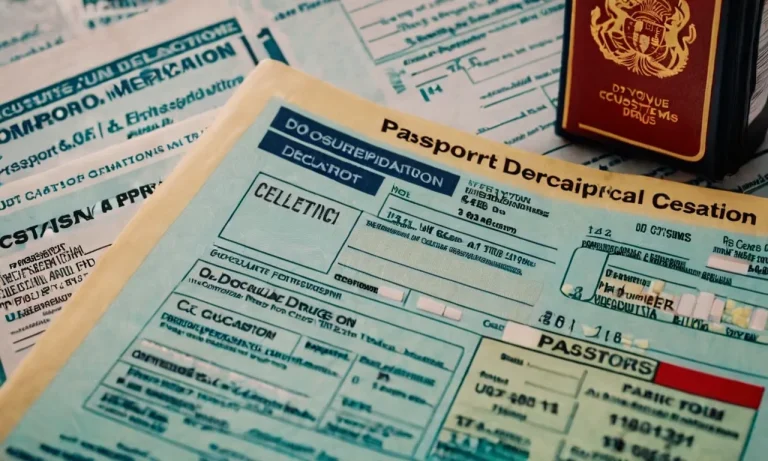The World’S Deepest Harbors
Harbors serve a vital purpose by allowing ships and boats safe refuge from storms and rough seas. But what makes a harbor truly impressive is the depth it reaches, allowing it to accommodate even the largest of vessels.
If you’re looking for the deepest harbors globally that can handle massive container ships and tankers, you’ve come to the right place.
The deepest harbor in the world is the Port of Long Beach in California, United States, reaching depths of 76 feet. Other remarkably deep harbors include the Port of Los Angeles in California at 72 feet, the Port of New York and New Jersey at 50 feet, and the Port of Antwerp in Belgium at 57 feet.
Deepest Harbors in North America
North America is home to some of the world’s deepest harbors, which play a crucial role in facilitating international trade and commerce. These deep harbors are capable of accommodating large vessels and provide access to major cities and transport hubs.
Let’s take a closer look at some of the deepest harbors in North America.
Port of Long Beach, California – 76 feet
The Port of Long Beach, located in California, is one of the deepest harbors in North America, with a depth of 76 feet. It is also one of the busiest ports in the United States and serves as a major gateway for trade with Asia.
The port handles a wide range of cargo, including petroleum, automobiles, and consumer goods. With its deep harbor, the Port of Long Beach can accommodate some of the largest container ships in the world, making it a vital link in global supply chains.
Port of Los Angeles, California – 72 feet
Adjacent to the Port of Long Beach is the Port of Los Angeles, another deep harbor in California. With a depth of 72 feet, it is one of the busiest and deepest harbors on the West Coast of North America.
The Port of Los Angeles handles a diverse range of cargo, including containerized goods, petroleum, and automobiles. It is a key economic driver for the region, supporting thousands of jobs and contributing significantly to the local economy.
Port of New York and New Jersey – 50 feet
The Port of New York and New Jersey is one of the largest and deepest harbors on the East Coast of North America. With a depth of 50 feet, it is capable of accommodating large container ships and bulk carriers.
The port complex handles a wide range of cargo, including containers, petroleum, and bulk commodities. It serves as a major gateway for international trade, connecting the United States with Europe, Asia, and other parts of the world.
Having deep harbors is crucial for ports to handle larger vessels and maximize their cargo capacity. These deep harbors in North America not only contribute to the growth of international trade but also play a significant role in the economic development of their respective regions.
Deepest Harbors in Europe
Port of Antwerp, Belgium – 57 feet
The Port of Antwerp, located in Belgium, is known for being one of the deepest harbors in Europe. With a depth of 57 feet, it is capable of accommodating large vessels and handling a significant amount of cargo.
The port is strategically positioned on the Scheldt River and connects to the North Sea, making it an important hub for international trade. It offers a wide range of facilities and services to support various industries, including shipping, logistics, and petrochemicals.
Port of Rotterdam, Netherlands – 59 feet
The Port of Rotterdam, situated in the Netherlands, is another notable deep harbor in Europe. With a depth of 59 feet, it is one of the busiest and largest ports in the world. The port has a long history and has played a crucial role in the country’s economy.
It serves as a gateway to Europe, connecting the continent to global markets. The port’s deep waterways allow for efficient navigation of large ships, enabling the handling of massive amounts of cargo. It offers a wide range of services, including storage, transshipment, and distribution.
Port of Hamburg, Germany – 52 feet
The Port of Hamburg, located in Germany, is renowned for its deep harbor, with a depth of 52 feet. It is one of the busiest ports in Europe and a key player in international trade. The port is situated on the river Elbe and provides access to the North Sea.
It offers state-of-the-art facilities and infrastructure to handle various types of cargo, including containers, bulk, and general cargo. The port’s deep water depth allows for the efficient handling of large vessels, contributing to its status as a major logistics and transportation hub.
Deepest Harbors in Asia
Asia is home to some of the world’s deepest harbors, providing crucial access for international trade and shipping. These harbors have been developed and expanded over the years to accommodate larger vessels and increase trade capacity. Let’s take a closer look at some of the deepest harbors in Asia:
Port Klang, Malaysia – 59 feet
Port Klang, located in Malaysia, boasts one of the deepest natural harbors in the region. With a depth of 59 feet, it is capable of handling large container ships and bulk carriers. The harbor plays a significant role in Malaysia’s economy, serving as a major gateway for international trade.
It is equipped with state-of-the-art facilities and efficient logistics systems to ensure smooth operations.
Port of Shanghai, China – 52 feet
The Port of Shanghai, situated in China, is not only one of the busiest ports in the world but also one of the deepest. With a depth of 52 feet, it has the capacity to handle massive container ships and is a vital hub for global trade.
The port’s strategic location on the Yangtze River Delta has made it a crucial link between East Asia and other parts of the world. Its advanced infrastructure and efficient operations have contributed to its success as a major international trading port.
Jawaharlal Nehru Port, India – 50 feet
Jawaharlal Nehru Port, located in India, is another deep harbor that plays a crucial role in the country’s maritime trade. With a depth of 50 feet, it can accommodate large container vessels and handle a significant volume of cargo.
The port is strategically located near India’s financial capital, Mumbai, making it a vital gateway for international trade. It has modern facilities and efficient logistics operations to ensure smooth movement of goods.
These deep harbors in Asia not only facilitate international trade but also contribute significantly to the economies of their respective countries. They serve as important gateways for imports and exports, connecting businesses with global markets.
The development and maintenance of these deep harbors require substantial investments and continuous efforts to ensure their efficiency and competitiveness in the ever-growing global trade industry.
Deepest Harbors in Africa
Port of Durban, South Africa – 48 feet
The Port of Durban, located in South Africa, boasts one of the deepest harbors in Africa, with a depth of 48 feet. This bustling port serves as a major gateway for international trade in the region, handling a significant volume of cargo each year.
Its deep harbor allows large vessels to navigate easily, ensuring efficient and smooth operations for shipping companies. The Port of Durban plays a crucial role in the economy of South Africa, facilitating trade and contributing to the country’s growth and development.
Port of Mombasa, Kenya – 45 feet
Situated on the eastern coast of Africa, the Port of Mombasa in Kenya is another deep harbor in the continent, with a depth of 45 feet. It serves as the principal seaport for the country and is a vital link for international trade in East Africa.
The Port of Mombasa handles a diverse range of cargo, including containers, bulk commodities, and petroleum products. Its deep harbor enables it to accommodate large vessels, making it an attractive choice for shipping companies operating in the region.
Port of Lagos, Nigeria – 43 feet
The Port of Lagos, located in Nigeria, is renowned for its depth of 43 feet, making it one of the deepest harbors in Africa. As the largest port in West Africa, it serves as a major gateway for trade in the region.
The port handles a significant volume of imports and exports, contributing to Nigeria’s economy. Its deep harbor allows for efficient handling of cargo, ensuring smooth operations and facilitating international trade.
The Port of Lagos is a vital component of Nigeria’s infrastructure and plays a crucial role in the country’s economic development.
These deep harbors in Africa play a significant role in facilitating international trade and boosting the economies of their respective countries. The availability of deep ports allows for the smooth handling of cargo and enables larger vessels to dock, ensuring efficient operations for shipping companies.
As a result, these ports serve as major gateways for trade, attracting investments and contributing to economic growth in the region.
Deepest Harbors in Australia
Port Botany, Sydney – 50 feet
Australia is home to some of the world’s deepest harbors, and one of them is Port Botany in Sydney. With a depth of 50 feet, it is a major shipping hub and plays a crucial role in the country’s economy.
Situated in Botany Bay, this harbor is known for its excellent navigational facilities and state-of-the-art infrastructure. It handles a wide range of cargo, including containers, bulk materials, and petroleum products.
Port Botany is also equipped with modern container terminals, making it a vital gateway for international trade. For more information, you can visit the Port Authority of New South Wales website.
Port of Brisbane – 42 feet
Another deep harbor in Australia is the Port of Brisbane, which boasts a depth of 42 feet. Located in Queensland, this harbor is strategically positioned to handle both domestic and international trade.
The Port of Brisbane is known for its efficient operations and excellent connectivity, making it a preferred choice for shipping companies. It has specialized terminals for various types of cargo, including containers, vehicles, and bulk materials.
With its strong infrastructure and deep water channels, the Port of Brisbane continues to contribute significantly to Australia’s maritime industry. To learn more about this harbor, you can visit the Port of Brisbane website.
Port Adelaide – 40 feet
Port Adelaide, located in South Australia, is yet another deep harbor in Australia with a depth of 40 feet. Situated on the shores of the Gulf St Vincent, this harbor has a rich maritime history and has played a vital role in the region’s development.
Port Adelaide offers excellent facilities for shipping and handles a diverse range of cargo, including containers, grain, and petroleum. Its deep water channels allow for the efficient movement of vessels, making it an important hub for international trade.
To find out more about Port Adelaide, you can visit the Flinders Ports website.
These deep harbors in Australia are not only essential for maritime trade but also contribute to the overall economic growth of the country. With their strategic locations, advanced infrastructure, and deep water channels, they continue to attract shipping companies from around the world.
These harbors serve as crucial gateways for imports and exports, connecting Australia to global markets. Their ongoing development and expansion initiatives ensure that they remain at the forefront of the country’s maritime industry.
Conclusion
As you can see, North America is home to the deepest harbors in the world at the twin ports of Long Beach and Los Angeles in California. Europe also has some remarkably deep harbors such as Rotterdam, Antwerp and Hamburg that can accommodate the world’s largest container ships.
The deepest harbors across Asia, Africa, and Australia still reach impressive depths between 40 to 60 feet. These enable them to handle large fuel and cargo tankers vital for global shipping and trade.
So next time you spot a massive vessel docked at one of these world-class ports, know that these harbors have the depth and infrastructure to match!








